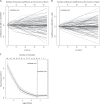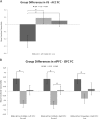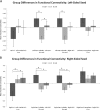Baseline and follow-up activity and functional connectivity in reward neural circuitries in offspring at risk for bipolar disorder
- PMID: 30755725
- PMCID: PMC6785101
- DOI: 10.1038/s41386-019-0339-2
Baseline and follow-up activity and functional connectivity in reward neural circuitries in offspring at risk for bipolar disorder
Abstract
Bipolar disorder (BD) is a serious psychiatric illness with demonstrated abnormalities in reward processing circuitry. Examining this circuitry in youth at familial risk for BD may provide further insight into the underlying mechanisms of BD development. In this study, we compared offspring of bipolar parents (OBP, n = 32), offspring of comparison parents with non-BD psychopathology (OCP, n = 36), and offspring of healthy parents (OHP, n = 39) during a functional magnetic resonance imaging reward processing task. Elastic net regression analyses identified 26 activity, functional connectivity (FC), and demographic variables that explained 34.24% of the variance in group (λ = 0.224). ANOVA and post-hoc analyses revealed that OBP had significantly lower right ventral striatum-left caudal anterior cingulate FC to loss (OBP versus OCP: p = 0.028, OBP versus OHP: p = 0.015) and greater right pars orbitalis-left (OBP versus OCP: p = 0.003, OBP versus OHP: p = 0.036) and -right (OBP versus OCP: p = 0.001, OBP versus OHP: p = 0.038) orbitofrontal cortex FC to reward versus OCP and OHP, respectively. These findings were not affected by non-BD psychopathology, psychotropic medication use, or symptomatology. There were no changes in, or relationships between, neuroimaging or symptom measures at follow-up (mean(SD) = 2.70(1.22) year inter-scan interval) in a subset of youth with follow-up data (OBP, n = 14; OCP, n = 8; OHP, n = 19). These findings suggest that lower right ventral striatum-left caudal anterior cingulate FC to loss and greater right pars orbitalis-orbitofrontal cortex FC to reward may be trait-level neural markers that may reflect risk for BD in at-risk youth. These findings comprise important steps toward identifying neural markers of BD risk, which may enhance early identification and guide interventions for youth at familial risk for BD.
Figures




Similar articles
-
Association of Neuroimaging Measures of Emotion Processing and Regulation Neural Circuitries With Symptoms of Bipolar Disorder in Offspring at Risk for Bipolar Disorder.JAMA Psychiatry. 2018 Dec 1;75(12):1241-1251. doi: 10.1001/jamapsychiatry.2018.2318. JAMA Psychiatry. 2018. PMID: 30193355 Free PMC article.
-
Preliminary investigation of the relationships between sleep duration, reward circuitry function, and mood dysregulation in youth offspring of parents with bipolar disorder.J Affect Disord. 2016 Nov 15;205:144-153. doi: 10.1016/j.jad.2016.03.074. Epub 2016 Jul 1. J Affect Disord. 2016. PMID: 27442458 Free PMC article.
-
White matter - emotion processing activity relationships in youth offspring of bipolar parents.J Affect Disord. 2019 Jan 15;243:153-164. doi: 10.1016/j.jad.2018.09.010. Epub 2018 Sep 11. J Affect Disord. 2019. PMID: 30243195 Free PMC article.
-
Differentiating between bipolar and unipolar depression in functional and structural MRI studies.Prog Neuropsychopharmacol Biol Psychiatry. 2019 Apr 20;91:20-27. doi: 10.1016/j.pnpbp.2018.03.022. Epub 2018 Mar 28. Prog Neuropsychopharmacol Biol Psychiatry. 2019. PMID: 29601896 Review.
-
Prefrontal, parietal, and limbic condition-dependent differences in bipolar disorder: a large-scale meta-analysis of functional neuroimaging studies.Mol Psychiatry. 2023 Jul;28(7):2826-2838. doi: 10.1038/s41380-023-01974-8. Epub 2023 Feb 13. Mol Psychiatry. 2023. PMID: 36782061 Free PMC article.
Cited by
-
Intrinsic Connectivity and Family Dynamics: Striatolimbic Markers of Risk and Resilience in Youth at Familial Risk for Mood Disorders.Biol Psychiatry Cogn Neurosci Neuroimaging. 2022 Sep;7(9):855-866. doi: 10.1016/j.bpsc.2022.02.009. Epub 2022 Mar 8. Biol Psychiatry Cogn Neurosci Neuroimaging. 2022. PMID: 35272095 Free PMC article.
-
Associations between parental psychopathology and youth functional emotion regulation brain networks.Dev Cogn Neurosci. 2024 Dec;70:101476. doi: 10.1016/j.dcn.2024.101476. Epub 2024 Nov 12. Dev Cogn Neurosci. 2024. PMID: 39541797 Free PMC article.
-
Brain functional activation and first mood episode in youth at risk for bipolar disorder.J Affect Disord. 2023 Jun 15;331:238-244. doi: 10.1016/j.jad.2023.03.025. Epub 2023 Mar 15. J Affect Disord. 2023. PMID: 36931569 Free PMC article.
-
Changes in Intrinsic Brain Connectivity in Family-Focused Therapy Versus Standard Psychoeducation Among Youths at High Risk for Bipolar Disorder.J Am Acad Child Adolesc Psychiatry. 2021 Apr;60(4):458-469. doi: 10.1016/j.jaac.2020.07.892. Epub 2020 Aug 1. J Am Acad Child Adolesc Psychiatry. 2021. PMID: 32745598 Free PMC article.
-
Neurobiology of bipolar disorders: a review of genetic components, signaling pathways, biochemical changes, and neuroimaging findings.Braz J Psychiatry. 2020 Sep-Oct;42(5):536-551. doi: 10.1590/1516-4446-2019-0732. Braz J Psychiatry. 2020. PMID: 32267339 Free PMC article. Review.
References
-
- Van Meter AR, Moreira AL, Youngstrom EA. Meta-analysis of epidemiologic studies of pediatric bipolar disorder. J Clin Psychiatry. 2011;72:1250–6. - PubMed
-
- Chase H W, Fournier J C, Bertocci M A, Greenberg T, Aslam H, Stiffler R, Lockovich J, Graur S, Bebko G, Forbes E E, Phillips M L. A pathway linking reward circuitry, impulsive sensation-seeking and risky decision-making in young adults: identifying neural markers for new interventions. Translational Psychiatry. 2017;7(4):e1096–e1096. doi: 10.1038/tp.2017.60. - DOI - PMC - PubMed
Publication types
MeSH terms
Grants and funding
LinkOut - more resources
Full Text Sources
Medical
Miscellaneous

